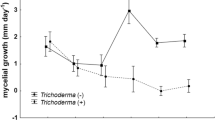Abstract
The genus Trichoderma is a potential biocontrol agent against several phytopathogenic fungi. One parameter for its successful use is an efficient coiling process followed by a substantial production of hydrolytic enzymes. The interaction between fifteen isolates of Trichoderma harzianum and the soil-borne plant pathogen, Rhizoctonia solani, was studied by light microscopy and transmission electron microscopy (TEM). Macroscopic observations of fungal growth in dual cultures revealed that growth inhibition of the pathogen occurred soon after contact with the antagonist. All T. harzianum isolates tested exhibited coiling around the hyphae of R. solani. The strains ALL23, ALL40, ALL41, ALL43 and ALL49 did not differ in coiling frequency and gave equal coiling performances. No correlation between coiling frequency and the production of cell wall-degrading chitinases, N-acetyl-β-d-glucosaminidase and β-1,3-glucanases, was found.





Similar content being viewed by others
References
Benitez T, Rincon AM, Limon MC, Codon AC (2004) Biocontrol mechanisms of Trichoderma strains. Int Microbiol 7(4):249–260
De Marco JL, Lima LHC, Valle de Souza M, Felix CR (2000) A Trichoderma harzianum chitinase destroys the cell wall of the phytopathogen Crinipellis perniciosa, the causal agent of witches broom disease of cocoa. World J Microbiol Biotecnol 16:383–386
El-Katany MH, Gudelj M, Robra K-H, Enaghy MA, Gubitz GM (2001) Characterization of a chitinase and an endo-1,3-glucanase from Trichoderma harzianum Rifae T24 involved in control of the phytopathogen Sclerotium rolfsii. Appl Microbiol Biotechnol 56:137–143
Howell CR (2003) Mechanisms employed by Trichoderma species in the biological control of plant diseases: the history and evolution of current concepts. Plant Dis 87:4–10
Innocenti G, Roberti R, Montanari M, Zakrissom E (2003) Efficacy of microorganisms antagonistic to Rhizoctonia cerealis and their cell degrading enzymatic activities. Mycol Res 107:421–427
Kubicek CP, Mach RL, Peterbauer CK, Lorito M (2001) Trichoderma: from genes to biocontrol. J Plant Pathol 83:11–24
Lima AL (2002) Molecular and biochemical characterization of Trichoderma isolated from Brazilian cerrado soil. PhD Thesis. Universidade de Brasília, Brasilia, Brazil
Mukherjee PK, Latha J, Hadar R, Horwitz BA (2003) TmkA, a mitogen-activated protein kinase of Trichoderma virens, is involved in biocontrol properties and repression of conidiation in the dark. Eukaryotic Cell 2(3):446–455
Noronha EF, Ulhoa CJ (2000) Characterization of a 29-KDa β-1,3-glucanase from Trichoderma harzianum. FEMS Lett 183:119–123
Omero C, Inbar J, Rocha-Ramirez V, Herrera-Estrela A, Chet I, Horwitz BA (1999) G proteins activators and cAMP promote mycoparasitic behavior in Trichoderma harzianum. Mycol Res 103(12):1637–1642
Silva RN , Silva SP, Brandão RL, Ulhoa CJ (2004) Regulation of N-acetyl-β-d-glucosaminidase produced by Trichoderma harzianum: evidence that cAMP controls its expression. Res Microbiol 155:667–671
Ulhoa CJ, Peberdy JF (1992) Purification and some properties of the extracellular chitinase produced by Trichoderma harzianum. Enz Microbial Technol 14(3):236–240
Vazquez-Garciduenas S, Leal-Morales CA, Herrera-Estrella A (1998) Analysis of the b-1,3-glucanolytic system of the biocontrol agent Trichoderma harzianum. Appl Environ Microbiol 64(4):1442–1446
Zeilinger S, Galhaup C, Payer K, Woo SL, Mach RL, Fekete C, Lorito M, Kubicek CP (1999) Chitinase gene expression during mycoparasitic interaction of Trichoderma harzianum with its host. Fungal Genet Biol 26(2):131–140
Acknowledgements
This work was supported by a biotechnology research grant to C.J.U. (CNPq and FUNAPE/UFG). A.L.L. and R.N.S are supported by CAPES/UNB and F.B.R.A. and F.M.C are supported by PIBIC/CNPq. The authors thank Dr. Sônia Nair Baó (UnB/Cel) for her support with electron microscopy.
Author information
Authors and Affiliations
Corresponding author
Rights and permissions
About this article
Cite this article
Almeida, F.B.d.R., Cerqueira, F.M., Silva, R.d.N. et al. Mycoparasitism studies of Trichoderma harzianum strains against Rhizoctonia solani: evaluation of coiling and hydrolytic enzyme production. Biotechnol Lett 29, 1189–1193 (2007). https://doi.org/10.1007/s10529-007-9372-z
Received:
Revised:
Accepted:
Published:
Issue Date:
DOI: https://doi.org/10.1007/s10529-007-9372-z




